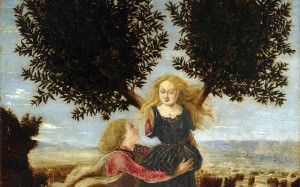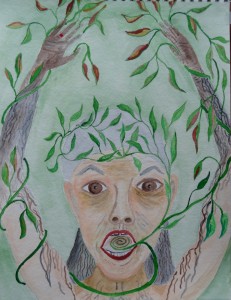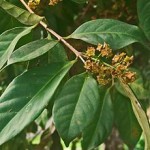Mythology, Nature and Healing: Daphne meets the Green Man


Eight days after my husband’s death, I dreamed of the Green Man, a pre-Christian northern European god of death and rebirth. Consciously, I knew him as a face on a garden gate, but the dream made me feel safe and directed me toward Nature where forest and fields comforted me when grief flooded in. The more I read the mythology of the Green Man, the more I understood the dream as a healing gift.

At that time, our mythology class was studying the myth of Orpheus and read one of Rainer Maria Rilke’s Sonnets to Orpheus each time we met. After discussing the poem, we painted or drew an image that grabbed our attention.
About ten weeks after Vic’s death, we read this:
Want the change. Be inspired by the flame
where everything shines as it disappears….
Pour yourself out like a fountain,
flow into the knowledge that what you are seeking
finishes often at the start, and, with ending, begins.
Every happiness is the child of a separation
it did not think it could survive. And Daphne, becoming a laurel,
dares you to become the wind.[i]

I understood “Want the change.” I wasn’t sure it was possible, but I had no choice. I heard how things shine as they disappear, the way my husband Vic radiated kindness and love in his dying days. I accepted the cycles of beginning and ending and knew about the necessity of a separation I thought I could not survive.
But Daphne? Who was Daphne?
I learned she was a minor Greek goddess or beautiful nature nymph associated with water. Apollo in one of his ignoble adventures chased her with the intent to rape and possess. Daphne prayed to the Earth for safety and was turned into a sacred laurel tree. Her leaves became the crown for winners in the Olympic games.

I felt an immediate connection to my Green Man dream and drew myself as Daphne becoming a tree. Thinking symbolically in the language of myth, Grief was my pursuer, abducting me into the dark underworld no matter how much I pleaded for help. So I painted myself as a Green Woman rescued by Nature and growing upward into life and light.
I later learned that Laurel (Daphne is the Greek name) was the plant of prophecy and poetic inspiration at Delphi. Besides garlands for winners, the tree gave us the names “poet laureate” and “baccalaureate.” Daphne is also bay leaf, a plant I use for soup. I had drawn the leaf shape correctly without knowing the connection.

Inspecting my drawing from seven years ago, I see more than I consciously knew at the time. I had connected the Green Man as cycling nature and Daphne as poetic inspiration by painting vines and branches emerging from the feminine spiral on my tongue.
Nature’s healing and the inspiration of Rilke’s poetry joined forces to help me move toward a new life.
[i] Part Two, XII from Sonnets to Orpheus, In Praise of Mortality, translated by Anita Barrows and Joanna Macy
***

For another piece about the Green Man, see The Green Man’s Guide to Life. I also wrote a post about another goddess called Home with Hestia.
With gratitude to Ellen Schmidt of Writing Room Workshops for her loving support and instruction. Ellen is a writer’s delight whose constructive well-considered feedback helps me see what works and what doesn’t. When I feel a piece has failed, she often points out the places that work. My book Leaning into Love emerged from early drafts written in Ellen’s classes.



March 6, 2019 at 3:59 pm
Brendan Graham Dempsey
Learning to express my psychological experiences in mythic terms was incredibly illuminating. For those interested in the topic, I started this site,
THE PERSONAL MYTHOLOGY PROJECT:
https://www.personalmythologyproject.com/
Cheers.
March 7, 2019 at 11:57 am
Elaine Mansfield
I looked over your beautiful site and will do more reading there this weekend. Thanks for sharing it here.
February 28, 2019 at 5:38 am
Andrea Mathieson
Hi Elaine, a lovely piece and wonderful that you also shared your drawings. The ‘voice’ of Daphne takes such a strong focus in that second drawing… and I’m not surprised Daphne continues ‘speaking’ her wisdom through you. I too deeply understand the healing power of nature, in times of pain of all description. My twenty years of exploration with plants evolved from the death of a baby and grew, like your wonderful work, in a body of deep wisdom. Another point of resonance, I did two body-maps in Ireland with Paula Reeves and still refer back to them as a powerful form of out-of-time biography, often predicting what is coming, not just present-moment understandings. Delving into these depths, through art, movement, writing, and deep listening yields an astonishing amount of wisdom. Aren’t we grateful!
February 28, 2019 at 4:45 pm
Elaine Mansfield
Thank you, Andrea. I hadn’t thought much about Daphne until reading the Orpheus Sonnets or what it might mean to turn oneself into a laurel tree. I had no idea your exploration and teaching began with the death of a baby. I can’t imagine anything much harder, but somehow you turned your tragedy into wisdom and helping others. Our mythology class did full body maps connected to a few myths. I haven’t done one for a long time, but it’s an interesting thought considering the transitions I’m going through with hearing and balance. I hope deep listening will come outwardly as well as inwardly. Yes, we are grateful! Endlessly grateful for the teachings and the teachers.
October 16, 2015 at 8:12 pm
Shirley Hershey Showalter
It must be thrilling, Elaine, to be guided by dreams, and led by clues and fragments into studying particular myths and drawing, literally, from your intuition, then later to see many more connections to the first images than you were consciously aware of. I feel a little shiver when that happens to me.
I remember reading Jean Bolen’s Goddesses in Every Woman long ago. I loved learning more about the myths and applying them to my life.
Keep exploring this vein!
October 17, 2015 at 9:10 am
Elaine Mansfield
It’s thrilling when an informative dream or insight comes my way, but then there are times like right now when I haven’t remembered a dream for almost a month. I feel a tad bit abandoned by the Unconscious, but dreams will return. They always do. I was so glad I put a date on the back of the Daphne/self-portrait watercolor. Once I had the date, I could look at dream notebooks and mythology class notes from that time and do a little excavating. The human archaeological dig for meaning.
Jean Shinoda Bolen has a new book about Artemis. I haven’t read it yet, although we’ve been studying Artemis in our mythology class for the second time. The first exploration was 20 years ago. This archetype means something quite different at my age than she did when I was a young woman and student. I embrace her wild solitude again.
Thanks for encouraging me.
October 12, 2015 at 7:13 pm
Aquileana
Good evening dear Elaine,
what a wonderful post…the way you related Rilke’s poem to transformation is compelling… I believe that the lessons you picked up here, even after the sadness that follows a mourning process, is hopeful.
The symbolism of the laurel is not only related to prophecies and Victory …
But to Apollo himself. Hence, I´d say that the myth teaches us that love is unconditional and always faithful.. even if the shapes, ways or circumstances change…
Excellent post. Thanks so much for sharing. Sending love and best wishes. Aquileana ☀️
October 13, 2015 at 10:39 am
Elaine Mansfield
Thank you, Aquileana. I included many lines from Rilke’s Sonnets to Orpheus in my book because my mythology class studied this myth and the sonnets while my husband was ill and after his death. They were a great help to me with lessons on holding the opposites of darkness and light in a conscious way. He found the green moss growing in a cemetery, or the delicious taste of a peach that is the same time the death of the peach. I’ve been reading your mythology articles. They are wonderful! And you share great images, too.
I’m trying to share a little about what I learn about loss and all of life from mythology and how I work with the images. As you can tell, I take mythological images personally, as though they are dream images. I want a solid foundation in the classical stories before trying to understand personal implications. Makes me so happy to use your work as a resource. Last night I read your piece about Hecate.
October 7, 2015 at 3:40 pm
Jill Swenson
Interesting for me to read about the myth of Daphne and how she turned into a laurel tree. I’ve previously read how the Green Man came to you but “Who the hell is this Daphne?” The bay leaf. Even though I know you and your writing this feels fresh and like something new. That works for me in your writing. I feel your passion for exploring the subject and the way you connect the dots for yourself and the reader makes this exciting to read.
October 7, 2015 at 3:58 pm
Elaine Mansfield
Thank you, Jill. It is new, just like the piece about Persephone. I’ve felt moved by this painting for years, but hadn’t thought much about what inspired me to paint it. I put it up so I could see it about a month ago. On the back, I had written the date and the Sonnet number I was drawing. (Want to kick myself each time I find a painting that isn’t labeled and I can’t recall.) I looked at those dates in journals and dream notebooks and re-read my penciled notes in the sonnet translation. Then I felt ready to write and see what would emerge. Inner research combined with google searches.
October 7, 2015 at 2:57 pm
Susan
A lovely post Elaine thank you! Who knew about the laurel and poet laureate?
Your paintings are lovely..as is your description of how one thing led to another, inter alia exploring the Daphne myth brings a wider expansion of thought and feeling. And steeping one’s self in Nature with all her moods and caprices bounty and joy, puts us further in touch with those deep underlying myths…
Please keep up the myth making and sharing! Thank you so much
October 7, 2015 at 3:38 pm
Elaine Mansfield
Thank you, Susan. I’m honored. You write so beautifully about mythology.
After a walk two days ago, I am moved to write about an insect infestation in a hemlock forest near me. It’s already hit 50% of the hemlocks in the eastern United States, but it just got here. I did a google search about the mythology of hemlocks and have found a few things. At first I thought I found a post by Jean Raffa, but I was mistaken. The website was laid out just like hers with the same colors and style. This person writes about Native American myth. More to explore.
October 7, 2015 at 10:51 am
Peggy Fry Keating
Bravo for a beautiful, rich piece of writing. It touched me deeply. I would urge you to continue bringing mythology into your writing.
October 7, 2015 at 3:32 pm
Elaine Mansfield
Thank you for encouraging words, Peggy. I hope you’ll also tell me where and how it doesn’t work.
October 7, 2015 at 6:17 am
Deborah
Wow! I’m in awe of your writing for it is deep, rich and so fertile! Such an excellent post which I found on Jean’s twitter … will look for you too Elaine (@LiberatedSheep) These words ‘I heard how things shine as they disappear’ blew this poet away, beautiful and divinely penned. You’re such an inspiration Elaine, love your drawings and all that you share. Blessings, Deborah.
October 7, 2015 at 11:10 am
Elaine Mansfield
Thank you, Deborah. There are many translations to ‘Sonnets to Orpheus.’ The Anita Barrows and JoAnna Macey translation is one I return to again and again for its poetry and accessibility. My German friend who is a translator says this one captures the spirit of Rilke better than many others. In our class, we read many translations to get the meaning beneath the words. He often leads me into myths I didn’t know, such as this one about Daphne. I feel encouraged by your comment and just connected with you on Twitter. I look forward to learning more. Blessings back to you on the other side of the Atlantic Ocean.
October 6, 2015 at 9:57 pm
D.G.Kaye
The links to your dreams and mythological figures is fascinating Elaine. Thanks for the sharing the story of Daphne and her becoming a laurel tree and her leaves becoming the symbol of victory. 🙂
October 7, 2015 at 11:03 am
Elaine Mansfield
Debby, I also love that Daphne cried out for help from Mother Earth. In most versions of the myth, the Earth is her Mother. You know too much about calling out to mother for help and receiving no response. Thanks for your comment.
October 7, 2015 at 8:24 pm
D.G.Kaye
You’ve got that right Elaine! Perhaps I am like Daphne. Her leaves became the crowns for winners is similar to my desire to uplift and empower others. Great analogy Elaine. xo
October 6, 2015 at 9:34 pm
Robin Botie
I love all this mythology stuff. Some day I want to learn more about Greek mythology. My daughter was really into it and wanted to do a Greek mythology tour. Someday. But meanwhile, it is comforting to hear about Daphne and Orpheus from you. And as for the Green Man, well, they have been a favorite of mine for a long time.
October 7, 2015 at 10:57 am
Elaine Mansfield
There are wonderful accessible books by Jungian writers about mythology. And many books I don’t know. Jungians love myth because of the archetypal and universal nature of the stories. Ancient myths help and guide me in the hardest times. Learning to write about them in an engaging way is another matter, but I vowed to try. A blog can only give a taste, but it’s a great way to experiment with my “mythology voice.”
October 6, 2015 at 8:13 pm
Patt Wisse
Mythology is beautiful and I just have not explored it enough. Now that I am older, I see more and more what relevance it has to life. I appreciate reading all that you write and I learn so much. Thank you for sharing
October 7, 2015 at 10:51 am
Elaine Mansfield
Thanks for your kind comment, Patt. Jungian writers help me get the most out of mythology and it’s terrific to be working with a group of women who love mythology as much as I do. There are wonderful models for most every human experience in these ancient stories, including aging and grieving. I hope all is well.